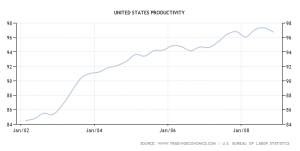
There was a time when you couldn’t get email on your mobile phone. No, seriously. The Blackberry didn’t exist yet, and “advances” in mobile phones consisted of nothing more than “making them flip open like a Star Trek communicator”(Google it if you don’t believe me).
The Dark Ages of Early Mobile.
 The mobile phone was first demonstrated in 1973, when its sole function was the horribly garbled transmission of the human voice. (Sadly, it stayed mobile’s sole function for almost thirty more years.)
The mobile phone was first demonstrated in 1973, when its sole function was the horribly garbled transmission of the human voice. (Sadly, it stayed mobile’s sole function for almost thirty more years.)
Not surprisingly, the end of the 20th Century was a dark time in the business world, too (kinda like the Middle Ages only without the bubonic plague). Employee productivity during this barbarous time stagnated because actual work could only be performed at the office or on desktop computers inside people’s homes (and never after dusk which was against English Guild rules).
A Renaissance of Productivity.
 The appearance of Blackberry devices at the turn of the 21st Century heralded the dawn of a New Age — business people could finally check their email while out of the office. Not coincidentally, productivity gains soared over the following years (see U.S. Productivity, 2003-2007).
The appearance of Blackberry devices at the turn of the 21st Century heralded the dawn of a New Age — business people could finally check their email while out of the office. Not coincidentally, productivity gains soared over the following years (see U.S. Productivity, 2003-2007).
Ubiquitous mobile access to email had removed a huge roadblock to getting work done. It allowed employees to communicate more quickly and easily, but email was still an ‘ad-hoc’ business system at best. Without any better alternatives, email became the go-to solution to every business need whether it was suited to it or not — sure, email can send file attachments, but it’s not a great place for sharing, storing, or finding documents. Even the 2007 introduction of the game-changing iPhone didn’t help much at first — numerous technological roadblocks to productivity continued to persist.
Growing pains in the Age of Digital Transition.
While mobile slowly advanced (polyphonic ringtones!), the digitization of business took off. Companies began converting and creating digital assets all over the place. New business systems and applications were introduced to facilitate and manage the chaos, but they just led to new problems down the road:
- File management — To organize a company’s growing digital assets, file-sharing services and intranets were adopted, storing important content outside their users’ daily activities.
- Application silos — Users of one business app were cut-off from other apps. Conversations were constrained within the apps themselves and weren’t available to users of other apps.
- Sub-par social — A lot of early attempts at social software used a “bolt-on” approach to existing intranets, creating yet another software system for employees to ignore.
The Age Of Real Productivity dawns.
These days, lots of disparate software systems are deployed within a single company, each representing a huge capital investment. So, obviously, the solution isn’t starting over from scratch. Luckily, with the tibbr platform, you don’t have to.
tibbr integrates all your business apps. Unlike other enterprise social networks, tibbr is a platform that’s app-agnostic. It can pull together all the business apps you already use so content and conversations can flow seamlessly back and forth between them. Users can access the system from their favorite app, tibbr itself, or the award-winning tibbr Mobile app.
tibbr Mobile lets people do real work. Email doesn’t let people do any actual work — sure, you can TELL someone to do something, but you can’t actually DO anything through email. The tibbr Mobile app lets employees directly approve or deny things in other apps like POs, expense reports, or vacation time.
tibbr keeps employees engaged. By integrating all the applications your business uses, tibbr becomes the one ‘go-to’ app where everything in the company happens. It’s also where everything your employee’s need to do their job is available through a single, easy-to-use interface.
Don’t let history repeat itself.
As history has repeatedly taught us, nothing reduces workplace productivity more than bad tools. That’s why smart businesses are deploying tibbr now, before their frustrated employees demand it (or just leave). Because the easier it is for employees to BE more productive, the more likely it is that they WILL be.
Try tibbr now.
tibbr is the complete productivity platform for businesses. To experience all the benefits of tibbr first-hand, sign up for a free trial of tibbr now.





